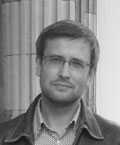NeuroCampus/DNC seminar: Vadim V. Nikulin
Vadim V. Nikulin from the Neurophysics Group, Department of Neurology, Charité - Universitätmedizin, and Bernstein Center for Computational Neuroscience, in Berlin, Germany is visiting Aarhus, and will give a guest talk
Info about event
Time
Location
DNC Auditorium
Organizer

Neuronal oscillations: new extraction technique, relevance to criticality in the brain and new oscillatory phenomenon
Vadim V. Nikulin
- Neurophysics Group, Department of Neurology, Charité - Universitätmedizin, Campus Benjamin Franklin, 12203, Berlin, Germany
- BernsteinCenter for Computational Neuroscience, 10115, Berlin, Germany
Abstract:
In the first part of the talk I will present a novel method for the reliable and fast extraction of neuronal oscillations from multi-channel EEG/MEG/LFP recordings. The method is based on a linear decomposition of recordings: it maximizes the signal power at a peak frequency while simultaneously minimizing it at the neighboring, surrounding frequency bins. Such procedure leads to the optimization of signal-to-noise ratio. We refer to this method as spatio-spectral decomposition (SSD). I will also show that SSD can be used as a pre-processing for a wide range of EEG/MEG studies, as a first real alternative to conventionally used PCA. In the second part of the talk I will present a concept of Long-Range Temporal Correlations (LRTC) in the brain. LRTC indicate that the autocorrelation of the amplitude envelopes decays very slowly, according to a power-law, which in turn indicates that the past neuronal activation has a capacity to affect a future neuronal recruitment. A presence of LRTC in the human brain might indicate that the brain operates at a metastable/critical state, which was theoretically shown to be beneficial for the optimal brain processing. I will show that LRTC can serve as clinical biomarkers reliably describing pathological neuronal activations in Schizophrenia, Alzheimer and Parkinson’s Disease. Finally, in the third part of the talk I will present new oscillatory phenomenon in human EEG: monochromatic ultra-slow oscillations (MUSO). The striking signature of these oscillations is their almost monochromatic spectral profile restricted to the frequency range 0.08–0.15 Hz. We also observed a significant coherence between MUSO and Oxy-Hb (NIRS)/arterial blood pressure. We hypothesize that MUSOs can occur due to the modulation of the blood-brain barrier DC potential by mechanical fluctuations related to hemodynamics or due to the skin vasomotion. The discovery of such possibly extraneuronally produced oscillations opens an avenue for studying hemodynamic responses with EEG technology and in addition poses a number of questions concerning the interpretation of previously recorded low-frequency neuronal oscillations in humans.
The guest talk will take place in:
DNC Auditorium (Palle Juul-Jensen Auditorium), AUH, Building 10G, Nørrebrogade 44, 8000 Aarhus C.
After the talk DNC offers refreshments - coffee and cake.
ALL ARE WELCOME!
